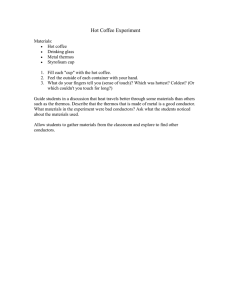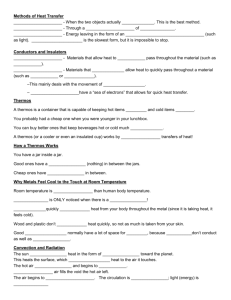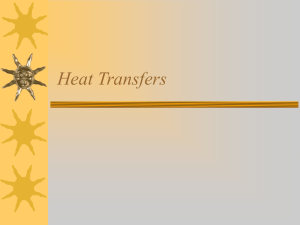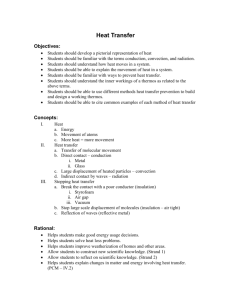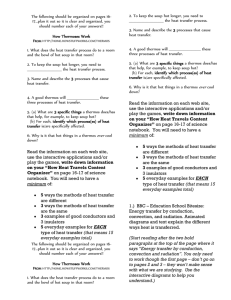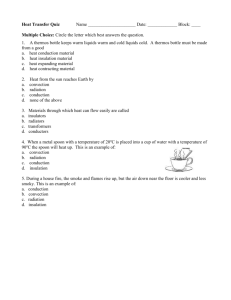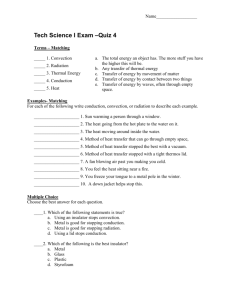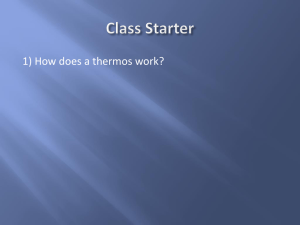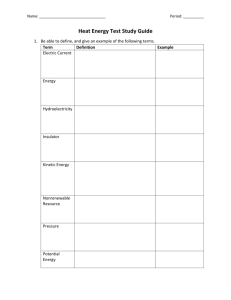How does a thermos work?
advertisement
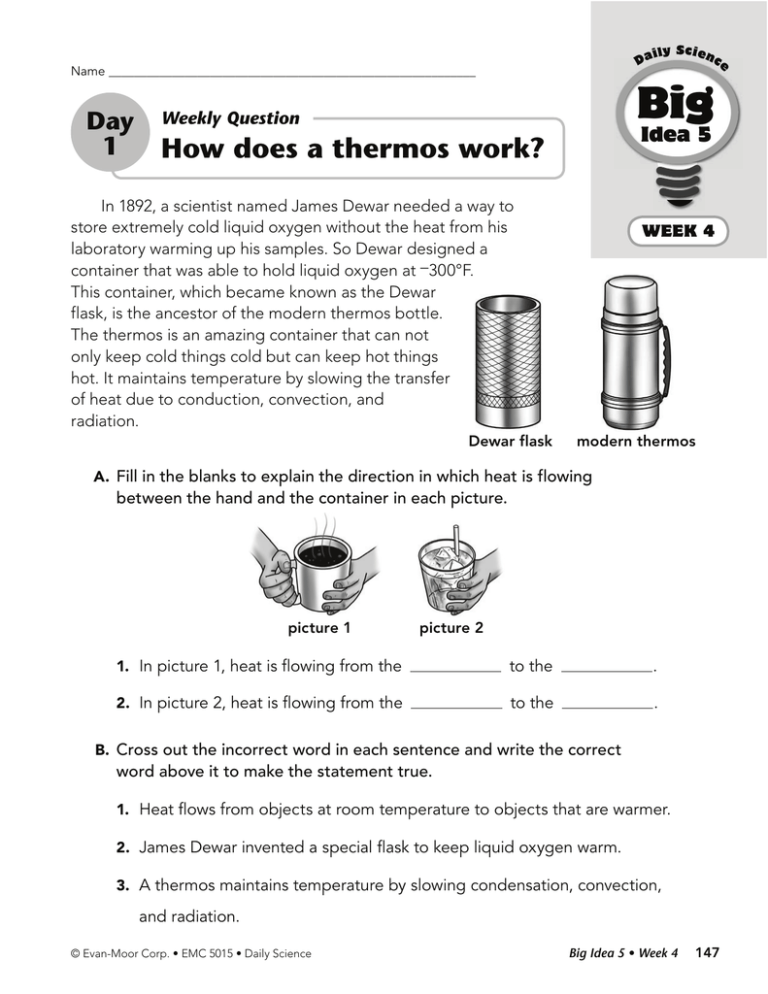
Da Name __________________________________________________________ Day 1 i l y S c i e nc e Big Weekly Question Idea 5 How does a thermos work? In 1892, a scientist named James Dewar needed a way to store extremely cold liquid oxygen without the heat from his laboratory warming up his samples. So Dewar designed a container that was able to hold liquid oxygen at –300°F. This container, which became known as the Dewar flask, is the ancestor of the modern thermos bottle. The thermos is an amazing container that can not only keep cold things cold but can keep hot things hot. It maintains temperature by slowing the transfer of heat due to conduction, convection, and radiation. Dewar flask WEEK 4 modern thermos A. Fill in the blanks to explain the direction in which heat is flowing between the hand and the container in each picture. picture 1 picture 2 1. In picture 1, heat is flowing from the to the . 2. In picture 2, heat is flowing from the to the . B. Cross out the incorrect word in each sentence and write the correct word above it to make the statement true. 1. Heat flows from objects at room temperature to objects that are warmer. 2. James Dewar invented a special flask to keep liquid oxygen warm. 3. A thermos maintains temperature by slowing condensation, convection, and radiation. PB-:";;>;><I" I-58E'/51:/1 147 Da Name __________________________________________________________ Day 2 i l y S c i e nc e Big Weekly Question How does a thermos work? Idea 5 One way to slow down the transfer of heat between objects is to keep them separated. This stops heat transfer by conduction, which WEEK 4 requires that objects physically touch each other for heat to flow from one to the other. A second way to slow conduction is by the use of insulators. Materials such as plastic, wood, and fabric are poor Vocabulary conductors of heat and therefore make good insulators. Air can work insulator as an insulator as well. For example, Styrofoam® cups have tiny air IN-suh-lay-ter pockets in the foam that keep heat from moving out or in. material that is a A thermos is basically a bottle inside poor conductor cup a bottle that limits heat conduction in both of heat ways—through the use of insulators and cap physical separation. The inner bottle, which is where you put your hot or cold drink, has little contact with the outside. The outer wall only places where heat can travel are through the thermos cap and at points inner wall where the inner and outer walls of the bottles meet. And to further reduce heat insulator conduction, these parts of the thermos are made from insulators. A. List the two ways a thermos bottle slows heat transfer by conduction. 1. 2. B. If you were designing a pot to cook spaghetti in, which parts would you make from good conductors of heat? Which parts would you make from insulators? Explain your answer. 148 -58E'/51:/1I" IPB-:";;>;>< Da Name __________________________________________________________ Day 3 i l y S c i e nc e Big Weekly Question Idea 5 How does a thermos work? While air is a good insulator, a vacuum is even better. That is because in a vacuum, heat cannot be transferred by convection. Remember that convection is the transfer of heat by movement of a gas or a liquid. Since there is no air in the space between the walls of a thermos bottle, convection of heat does not occur. In fact, another name for a thermos is vacuum bottle. Many devices utilize a vacuum. For example, foods that are vacuum-packed are sealed within a vacuum in order to keep air from touching the food and spoiling it. On the other hand, despite its name, a vacuum cleaner doesn’t actually contain a vacuum. But it does create one by pulling air through it when it is turned on. WEEK 4 Vocabulary vacuum VAK-yoom a space empty of air or other material hot liquid vacuum heat convection A. Write true or false. 1. Convection cannot take place in a vacuum. 2. A vacuum cleaner creates conduction when it is turned on. 3. The space between the thermos walls contains a vacuum. 4. A vacuum is a good conductor. B. Use words from the passage to complete the sentences. 1. Some foods are packed within a 2. PB-:";;>;><I" I-58E'/51:/1 to keep air out. requires the movement of a gas or a liquid. 149 Da Name __________________________________________________________ Day 4 i l y S c i e nc e Big Weekly Question How does a thermos work? The inside surface of the inner bottle of a thermos is shiny, like a mirror. This reflective surface is not just for looks. Shiny surfaces block the loss of heat energy through radiation, which is the movement of energy through matter and space. The shiny surface inside a thermos prevents heat from a hot drink from radiating out of the vessel. Some thermoses even have shiny outer surfaces. These surfaces reflect heat from outside the bottle and keep it from warming up cold drinks. reflective A thermos bottle is designed to slow surfaces the transfer of thermal energy by radiation, convection, and conduction, and it relies on reflective surfaces, a vacuum, and the use of insulators to do this. However, no container can completely stop all types of heat transfer. Even a thermos can only slow the flow of heat. Eventually, a hot or cold liquid in a thermos will reach room temperature. Idea 5 WEEK 4 A. Explain in your own words how the shiny surfaces of a thermos help keep hot drinks hot and cold drinks cold. B. The word thermos contains the Greek root therm, meaning “heat.” List three other words that contain therm and write their definitions. 1. 2. 3. 150 -58E'/51:/1I" IPB-:";;>;>< Da Name __________________________________________________________ e Big Weekly Question Day 5 i l y S c i e nc Idea 5 How does a thermos work? A. Use the words in the box to complete the sentences. WEEK 4 insulator room temperature conductors vacuum 1. To keep from burning his hand on the hot pan, the chef wore . an oven mitt as an 2. A limits the flow of heat by convection. 3. Metals are excellent of heat. 4. Although a thermos limits heat transfer, eventually its contents . will reach B. Write a caption for this diagram to explain how each labeled part of the thermos helps slow the flow of heat. Use the words conduction, convection, and radiation in your answer. insulator reflective surface vacuum insulator PB-:";;>;><I" I-58E'/51:/1 151
